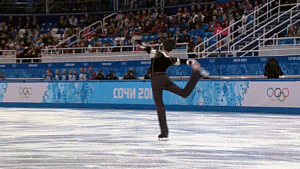Ah, December. It’s the month of giving and receiving gifts,
eating delicious foods, and celebrating Christmas. There’s another yearly even
that’s celebrated around the world during the first week of December, too, and
that is the annual Grand Prix Finals of
Figure Skating!
Figure
skating is one of the few sports that I actually pay attention to, and it’s
because the sport mixes technicality with artistry. Aside from having to
interpret the music through choreography, figure skaters also have to show that
they can do elements like jumping. As an example, here’s Boyang Jin, an
upcoming men’s skater, performing a jump called a quadruple lutz. (Isn’t he amazing?)
Boyang Jin executing a quadruple lutz
(from http://magicaleggplant.tumblr.com/post/151768838548/squad-intro-post-part-2-dj-boyang)
While the jumps
are amazing to watch, this isn’t the element that caught my attention. Allow me
to introduce you all to the element called spins,
which is also a skill that is essential to become a top-tier figure skater. In
most competitions, skaters are required to perform different types of spins
throughout their performance. One of my personal favorite spins is the Biellmann spin, which is also one of the
specialties of the Philippines’ very own figure skater, Michael Christian
Martinez.
Michael Christian Martinez executing a Biellmann spin at the 2014 Sochi Olympics
(from http://365daysofsexy.tumblr.com/post/76535912291/go-michael-christian-martinez)
Like me, I’m pretty sure some of you are wondering the same
thing: How do figure skaters do all these spins without feeling dizzy? I’m sure
that if I even tried to spin the way figure skaters do, I’d fall on the floor and
have a hard time getting up. In order to explain this, let’s talk about the vestibular system, which plays an
important role in balance.
(Goldstein, 2014)
Keeping our balance is something that we don’t really have
to think about. For instance, we can stand upright without giving it much
thought. In other words, we can say that our vestibular system is reflexive, in that conscious thought is
not as needed in order to maintain balance. We usually become aware of
balancing, though, when we’re in situations where our balance is thrown-off,
and in this case, spinning may be one of those instances.
In one particular study, a certain type of vestibular system
reflex was examined in figure skaters and non-figure skaters. This reflex is
called the vestibulo-ocular reflex,
which allows for the eyes’ gaze to be stabilized through compensatory eye
movements in the opposite direction of the body movement (Tanguy, Quarck,
Etard, Gauthier, and Denise, 2008).
In order to visualize how the vestibulo-ocular reflex works,
imagine yourself at an amusement ride called “Spinning Teacups”. When the ride
first starts, you would feel very dizzy at first, right? As you spend more time
in the ride, though, you slowly start to get used to it, until you won’t feel
as dizzy anymore. The vestibulo-ocular reflex also works like this. Our eyes go
through a slow compensatory phase first, which may alternate with fast phases (Tanguy,
Quarck, Etard, Gauthier, and Denise, 2008). The velocity of these slow phases
may peak, before exponentially decreasing to zero (Tanguy, Quarck, Etard,
Gauthier, and Denise, 2008).
As an example of the vestibulo-ocular reflex at work, look
at the figure skater below. This figure skater shown below can be seen to be
spinning in a counterclockwise direction; her vestibulo-ocular reflex would be
at work through eye movements in a clockwise direction.
Yuna Kim performing a spin sequence
(from https://s-media-cache-ak0.pinimg.com/originals/b6/57/ac/b657ac6a8e95cc5d83307557a8db954a.gif)
This
particular study by Tanguy, Quarck, Etard, Gauthier, and Denise (2008)
examined the vestibulo-ocular response
and the motion sickness among figure
skaters and non-figure skaters. These researchers wanted to examine the plasticity, or the flexibility, of the
vestibular system.
In order to simulate spinning, participants were secured in
a chair which rotated in different velocities and directions. Since the vestibulo-ocular
response focuses on eye movements, the researchers uses a method called video-oculography in order to record the
eye movements. After each session, the participants’ motion sickness was
examined using the Pensacola diagnostic index, which tested for the symptoms of
motion sickness.
The results of the study showed that the vestibulo-ocular
reflex of figure skaters, compared to non-figure skaters, were faster to adapt
and experienced significantly less motion sickness (and dizziness). The
researchers offered a possible explanation: vestibular
habituation (Tanguy, Quarck, Etard, Gauthier, and Denise, 2008). Since
figure skaters train for long hours, their vestibular systems also become more
efficient, and therefore also become more adapted to possible dizziness (Tanguy,
Quarck, Etard, Gauthier, and Denise, 2008).
From this study, we can see that our body’s vestibular
system is not fixed; we can train ourselves to have better balance. Figure
skaters have to go through training, and years of practice, in order to get
used to spinning. In the meanwhile, non-figure skaters, like me, can settle for
just admiring the amount of time and effort these figure skaters put into
training. To end this post, here’s a link to a performance of Yuzuru Hanyu,
2014 Olympic champion, ten-time world record breaker, and also a finalist in
this year’s Grand Prix Final. J
Yuzuru Hanyu's world-record breaking performance at the 2014 Sochi Olympics
References
Goldstein, E.B. (2014). Sensation and Perception (9th
ed.). Belmont, CA, USA; Cengage Learning.
Tanguy, S., Quarck, G., Etard, O.,
Gauthier, A., & Denise, P. (2008). Vestibulo-ocular reflex and motion
sickness in figure skaters. Eur J Appl
Physiol, 104, 1031-1037. DOI 10.1007/s00421-008-0859-7



No comments:
Post a Comment